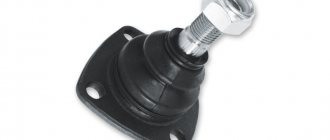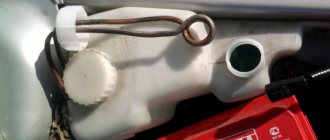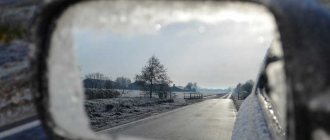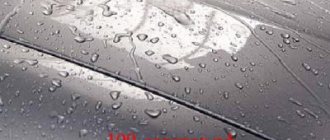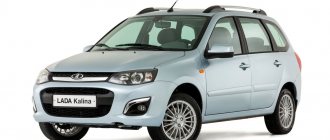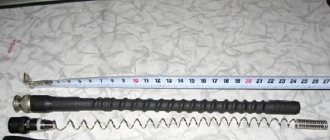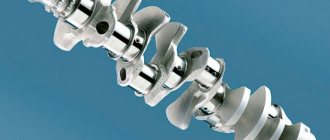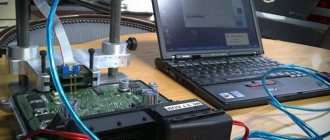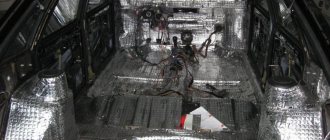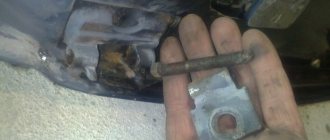You can make your own anti-rain from silicone spray, paraffin with solvent, WD-40, Lenora, or even construction sealant. At the same time, in terms of functional qualities, the finished product will hardly differ from the best factory version. Below we present the main ways to make anti-rain for a car with your own hands, we present basic recipes and their features. Let's consider what such compositions are usually prepared from, what are the pros and cons of each option. Talk separately about the rules for applying such products to a car.
How to make anti-rain with your own hands
There are several ways to make a homemade anti-rain and thereby save money on purchasing an original product. Below we present the most popular options, which have many positive reviews and are considered the most attractive among car owners.
Silicone spray
When considering options on how to make anti-rain for car glass yourself, it is worth highlighting a solution with silicone glue. This lubricant is very similar in composition to polymer silicone, and after it gets on the surface of the glass, it forms a protective layer and fills all the unevenness on the surface. It also has excellent hydrophobic properties.
The disadvantages of silicone spray include a short service life (it washes off quickly), the need for high-quality cleaning before processing, a negative effect on paintwork and the requirement for mandatory rubbing/polishing.
Paraffin and solvent
No less popular is paraffin anti-rain, which everyone has on their household. In addition to the paraffin itself, you will also need white spirit. If you don’t have a candle at hand, you can replace it with a liquid paraffin composition.
Now let's look at how to make anti-rain for glass with your own hands. The algorithm is like this:
- Grind the candle using a grater or knife. This is necessary to speed up the process of dissolving paraffin.
- Take 10 g of paraffin and fill it with 200 ml of white spirit.
- Mix the resulting composition and wait until completely dissolved.
- Apply anti-rain composition for car windows to the surface.
- Using a cloth or soft cloth, polish the surface until transparent.
Please remember that the use of other solvents is not recommended and may damage the paintwork.
WD 40
If paraffin and white spirit are not suitable for DIY anti-rain, use WD 40. This is a universal product that has excellent hydrophobic properties and can protect the surface of the car from snow and rain. It must be applied to a dry/clean surface and then rubbed in. To ensure stable protection, the frequency of treatment is once every 10 days.
Lenore
To make anti-rain for car glass with your own hands, you can use a recipe using Lenore. This is a standard concentrate with a good water-repellent effect. After treating the surface, moisture rolls off and does not linger on the surface, and making the product yourself is not difficult.
The algorithm of actions is as follows:
- Prepare Lenore, distilled water and an empty mixing container.
- Pour a Lenore cap into the empty bottle.
- Add 3-4 liters of water and mix everything.
- Pour the product into the windshield wiper tank.
- Treat the windshield through the nozzles.
The main disadvantage of this anti-rain folk remedy is the appearance of a bluish film on the windshield. At night the plaque is almost invisible, but in the daytime it can impair visibility.
Construction sealant
To make an anti-rain windshield with your own hands, you can use construction sealant. This is another product that easily copes with liquid repulsion and is made on a silicone basis. To make it, do the following:
- Take 50 g of white spirit solvent.
- Measure out a teaspoon of construction sealant (preference should be given to neutral compounds).
- Mix everything in a clean container until smooth.
To apply anti-rain for a car body made by yourself, it is better to use a sprayer, and then carefully distribute the composition over the surface. At the same time, the product does not leave streaks / marks, protecting against contamination.
What is the use of the anti-rain product?
Recently, car owners are increasingly using such a product as “anti-rain” for their cars. The substance is a chemical composition intended for application to the surface of glass in order to remove precipitation under the influence of oncoming air flow. “Anti-rain” is applied to the working surface of the glass, and after the volatile compounds evaporate, a protective layer is formed that interacts with the glass. This polish fills microcracks, scratches and other defects. After this, the car just needs to pick up a certain speed during the rain, and the water will fly off under the air currents without interfering with the view. In this case, there is no need to turn on the wipers.
Video: how “anti-rain” works
What is anti-rain made of?
Many questions concern what official manufacturers make anti-rain from. In most cases, silicone-based polymers and solvents are used. The composition may also include additional chemical components that provide high wear resistance to the layer. Depending on the composition, the validity period of the product can be adjusted, which reaches six months. If you make the product yourself from the ingredients discussed above, the service life will be shorter.
What it is
Not everyone fully understands what this anti-rain coating is and what effect it gives when applied to glass surfaces. The basis for creating such substances are polymers, silicone and organic solvents. The recipe is extremely simple, which is why many car owners make analogues of branded anti-rain products on their own. Moreover, they often work no worse than those that are sold for big money in small bottles.
The effect is based on surface wettability. Since anti-rain is used mainly on the windshield, and less often when treating the body, glass is considered a well-wettable coating. That is, when water and dirt get in, they begin to spread across the glass, combine with other drops, and form something like a puddle. All this gradually flows down due to the influence of gravity.
Anti-rain on the hood
But anti-rain turns a hydrophilic coating into a hydrophobic one. Due to this, droplets do not spread over the surface. They gather into balls, which roll down very quickly. Especially when the car is moving at relatively high speeds. The oncoming flows of oncoming air literally sweep away the water, as soon as you accelerate to more than 60 kilometers per hour.
In other words, after treatment, a protective water-repellent layer is formed on the surface. When water gets in, a stable and fairly long-lasting repulsion effect occurs. Drops no longer linger on the coating for a long time, and under the influence of gravity and oncoming wind flows flow down or scatter to the sides, providing excellent visibility to the driver even without turning on the windshield wipers. Although the need to use windshield wipers in bad weather should never be ignored.
At the same time, high-quality anti-rain has several key advantages:
- has a positive effect on traffic safety;
- does not cause any harm to paintwork and glass;
- works for quite a long time.
Many people are extremely skeptical about anti-rain products. But this can be explained quite simply. There are high quality products on the market. But along with them, fakes are sold, as well as drugs with extremely low effectiveness. Typically, manufacturers of such solutions promise a lot, but in reality consumers are disappointed.
And here there are 2 main options:
- buy a ready-made product from a leading brand for a lot of money;
- try to make anti-rain yourself.
Everyone decides for themselves which path to take. The costs of quality substances are largely justified. But homemade products give you a rough idea of what to expect from anti-rain. If the result is satisfactory, then car owners switch to professional means, since everything is much simpler with them. I bought it, applied it and enjoy the effect of protection against water and dirt.
Packaging options
When planning to purchase an anti-rain product, you should also take into account what kind of packaging it is better to buy such a product in.
Everything is quite simple here. Any anti-rain is a special liquid. This does not allow you to buy the drug in pieces or by weight. In most cases, vials are used.
But the bottles can differ significantly from each other. Some are very convenient to use, others are extremely poorly thought out in design. For some, application is carried out using a built-in sprayer, while other anti-rains have a sponge at the end.
There is another category of products that, in appearance and principle of use, resemble sponges intended for cleaning shoes. Inside such a sponge there is a capsule that is crushed before direct use, the anti-rain is absorbed into the sponge, and treatment begins.
But sponges have one big disadvantage. They are disposable and often very expensive. The amount of anti-rain in the capsule is minimal, and at best, the motorist will be able to completely treat one windshield. You can't count on more.
Possible disadvantages and duration of effect
Motorists are rightly interested in how positive the effect will be and how long it will last, and whether applying anti-rain to the body or glass will result in negative consequences.
The advantages are clear and obvious. As for the disadvantages, in theory, when using a high-quality branded or homemade anti-rain, no side effects arise.
But car enthusiasts note that over time, the effect of the anti-rain begins to decrease, the drops become increasingly smaller and settle on surfaces in the form of small beads, thereby interfering with the driver’s normal visibility through the windshield, side windows and rear-view mirrors.
But a gradual decrease in efficiency is quite natural, since none of the responsible manufacturers will guarantee constant operation of the anti-rain device. If you see on the packaging that after one application the driver will supposedly forget forever about the problems associated with rain and dirt on the body and glass, then you definitely shouldn’t believe them.
We can give one more useful advice to those who often use such products, giving preference to different manufacturers. Before using a new anti-rain of a different shape and composition, it is imperative to remove the remnants of the old coating. This is done by treating glass and paint surfaces with alcohol-based cleaners. Special products for removing the anti-rain itself are also available for sale. But so far they are rare, plus they are somehow too expensive.
Comparison of folk remedies and purchased ones (pros and cons)
With this in mind, the question arises which product is better to choose - official or homemade. To do this, you need to understand the advantages and disadvantages of each option.
Official product
Pros:
- Application of tested technology.
- Long service life.
- Efficiency guaranteed.
- Convenient containers and a large selection of all kinds (from washer fluid in the washer reservoir to special film).
- Ready for application.
Minuses:
- Additional expenses.
- It's hard to wash off glass.
- You need to analyze the characteristics, read reviews and buy.
With your own hands
Pros:
- Minimum expenses.
- Use of improvised means.
- Possibility to choose one of many options.
Minuses:
- Risk of damage to glass and body.
- Questionable effectiveness.
- Low service life.
Experience of car enthusiasts
I used High Gear, I liked the effect, but not for long, on average it was enough for a week in normal weather, in rainy weather for 3-4 days. It's been on my brother's side windows for six months now, the effect is amazingly visible. I heard that RainX is for sale somewhere in METRO, I'm looking for it. In England, the guys only use it.
Brain
https://forum.car-care.ru/index.php?showtopic=45
Made by turtle, it rubs in without leaving a residue, lasts about 3 months. All glass is rubbed in half an hour, a very convenient thing. Costs a penny, no cons found. There are left-wing anti-rains, but you get tired of applying them, you rub and rub, and the glass is covered in a whitish coating.
506
https://highlander-autoclub.ru/forum/index.php?threads/Antidozhd.10348/
I apply the usual anti-rain from Turtle and someone else. I apply it myself, the method is simple, but it lasts for a maximum of a month - this is ideal, but 2 weeks is good, then the effectiveness drops considerably, but it’s done quickly: I washed the glass, applied it, rinsed it, wiped it off.
RRC
https://highlander-autoclub.ru/forum/index.php?threads/Antidozhd.10348/
Turtle Wax is quite an anti-rain medicine - ours, cheap, cheerful, helps a little. Runway Rain - quite enough, at work they give it. Aquapel - spoiled. Q2 View - very expensive, good, they used to give it at work, then they stopped.
Lokot
https://wroom.ru/index.php?id=forumtopic&topic=18523
It is quite popular among car enthusiasts to independently prepare “anti-rain”. This is due to the low cost of the components and their efficiency. In addition, special skills are not required to obtain this or that composition. Every car owner can prepare such a product, since it will require a minimum of time and financial costs.
How to apply on glass
Regardless of where the anti-rain was taken - made with your own hands or bought in a store, the principle of application is identical in all cases. Take the following steps:
- Wash the entire car well with clean water.
- Apply ammonia cleaner to the glass.
- Rub the surface until it is shiny and streak-free.
- Leave the glass to dry.
- Apply anti-rain with your own hands.
- Wait for it to dry.
- Polish until completely transparent.
Remember that when applying, do not use hard rags or sponges, which can leave scratches on the surface.
Now you know how to make anti-rain with your own hands, what are the features of each method, and is it worth the risk of creating a solution. In the comments, tell us what method you used and what other methods of making glass protection can be used.
Where did the remedy come from?
It is not difficult to understand the essence of such a solution as anti-rain coating. Every motorist probably knows how serious and dangerous an obstacle on the road becomes heavy rain or downpour. Water not only forms puddles on the asphalt, causing the risk of aquaplaning, but also significantly impairs the visibility of the road.
To minimize the impact of water falling from the sky on the driver’s view of the roadway, a product such as anti-rain is used, which is actively used for cars. But long before it appeared on sale in car dealerships and attempts to recreate the recipe with your own hands, the technology was used in the defense industry.
Special substances were used in aviation and in the creation of space satellites, rockets and other installations. They were designed to prevent excessive moisture accumulation on the fuselages, which helped cope with the icing problem.
After the aviation and space industry, the so-called anti-rain, which ensured the creation of a stable hydrophobic film, entered service with the military. Here, optical components were treated with preparations so that moisture would not interfere with the study of the surrounding environment.
The result largely met even the wildest expectations. Experts admitted that after treatment, various wet dirt, water and snow rolled off the surfaces, leaving virtually no traces. This guaranteed maximum visibility in bad weather conditions.
The technology could not remain unnoticed by civilian consumers for a long time, and passed into the hands of ordinary people. And anti-rain looks most promising in relation to the automotive industry and vehicle operation. Anti-rain is not developed using secret technology, and therefore each manufacturer has the opportunity to sell the product on the market.
I want to say two things
First, you can now tell me: “The branded anti-rain, which is sold in bottles of 250-300 ml, is actually more than our small bottle of 15 ml.”
Friends, yes, this is all true, all this is true, but, firstly, this bottle costs 200-500 rubles, and secondly, it contains diluted silicone, that is, it is diluted with some kind of surfactant.
A very small percentage of silicone is taken there, maybe the same amount as in this 15 ml bottle, and everything is diluted with surfactants so that you can apply it normally to your windshield.
Here the silicone comes undiluted, concentrated, and you apply these really small droplets to the surface that needs to be treated and rub it.
It works even better than the branded one in a can that needs to be sprayed.
Independent production and application of anti-rain coating
The main task of the coating is to prevent the retention of water and dirt on the surface of the glass; therefore, the composition is based on elements with exceptional water-repellent characteristics.
In our case, we recommend using paraffin. We will also include white spirit solvent in the composition to give the paraffin the required degree of liquid.
Without going into chemical details, we will inform you that paraffin has exceptional qualities in terms of creating a repelling effect for water.
Let’s say about white spirit that, despite its chemical aggressiveness, you should not worry about the glass surfaces of the body - it will not cause any harm to vehicle windows. However, given its high volatility and flammability, some precautions must be taken when working with the solvent.
So, what do we need to create a future anti-rain coating:
1. Paraffin candles 2. Solvent – White spirit 3. To apply the coating, use cotton pads, napkins or any type of non-woven fabric.
Manufacturing of anti-rain coating:
1. Carefully grate a candle weighing about 10-12 grams on a fine grater. 2. Prepare a container into which then pour 100 milliliters of white spirit 3. Place the grated paraffin into the solvent 4. Stir slowly and thoroughly until the paraffin dissolves.
The composition is ready, now proceed directly to preparing and applying the resulting composition to the glass:
It is important to remember that the finished composition is applied only to thoroughly washed and cleaned glass. After the car windows have been washed with all kinds of cleaning compounds, you need to remove any remaining moisture by rubbing it with a special paper napkin or just newspaper. After the glass is washed, treat it with a degreasing alcohol solution.
Pay special attention to the corners of the glass, where dirt and liquid most often remain after washing. The glass must be clean and there should be no streaks or remaining dirt streaks.
After the glass surface has completely dried, begin applying the composition. Using cotton pads, special car wipes or soft non-woven material, dipping it into the composition, apply the resulting anti-rain composition to the surface of the glass.
After complete drying, you need to polish the windows of your car using the same newspapers, napkins, or non-woven material. Be careful when polishing - do not scratch the car glass with old dry dirt or grains of sand. At this point, accuracy and caution are required.
Once polishing is complete, you will be surprised at how much lighter and clearer your car's glass becomes.
How does he work
During the operation of the car, more microcracks gradually form on the surface of the glass and paintwork of the body. They promote the adhesion of particles of various contaminants and interfere with their timely and complete removal. The elements of the car located at the front - the windshield and the front part of the hood - are especially susceptible to this effect. They are particularly affected by the incoming air flow, which contains a significant amount of abrasive elements.
Anti-rain for cars helps to increase the resistance of the treated surface to the external environment and minimizes the negative effect of existing microdamages. A thin, water-repellent, hydrophobic layer is formed on the surface of the glass or paint coating treated with it. It fills all microcracks and forms a particularly smooth surface on which dirt particles practically do not linger. The water falling on it does not spread - small balls are formed from it, which easily flow down under their own weight.
When driving at speeds over 70 km/h, water and wet snow leave the windshield treated with it, even without the use of wipers, under the influence of the oncoming air flow.
There are separate types of this product for processing glass and bodywork. However, any anti-rain for cars basically has identical components that help repel water suspension, but different types of solvents and fixing additives.
Anti-corrosion water-repellent grease WD - 40
A number of useful properties of WD-40 lubricant have been known for a long time, the main of which are:
- displacement of moisture;
- protection from moisture and prevention of corrosion;
- cleaning the surface from glue, grease and bitumen stains;
- lubrication of metal parts.
The main elements included in the chemical composition of WD - 40:
- White spirit solvent;
- ferromones;
- carbon dioxide required for atomization.
WD-40 can also be used as an anti-rain for glass and bodywork
This chemical composition and the objectives of WD-40 predetermined its use as an anti-rain. The aerosol can be used both for glass and for the car body. The process of applying it is similar to the case with paraffin anti-rain. Surfaces must be washed, degreased and dried before application. After application to the surface, the aerosol is thoroughly rubbed in and the treated surfaces are polished. The disadvantage of using the product is its relative fragility.
Standard glass cleaning equipment
To clean glass, cars already have windshield wipers, but during operation, their efficiency decreases due to the appearance of scratches and microcracks on the glass, which may not even be visible without special equipment. These defects make the glass rough, which prevents water droplets from flowing off it. In addition, car wipers have a short service life and their performance decreases over time.
It is also worth noting that windshield wipers do not clean all glass, especially since they are intended only for the windshield. The side windows are not cleaned at all, and the rear window - even with a wiper - has a small cleaning area.
Body protection using anti-rain compound
Using a similar coating that you just covered the car windows with, you can effectively protect the car body.
The result of protecting the body with an anti-rain coating will be identical to the effect obtained for glazing
If on dirty days in winter when actively driving around the city, you sometimes have to wash your car twice a day, if you prefer to drive a clean car, then after applying the anti-rain coating, the surface of the body will be protected from dirt for 3-4 weeks.
Therefore, why spend a significant amount of money on covering a car with “liquid wax” at a car wash, when you can successfully carry out a similar procedure yourself and be confident in the result, guaranteeing with careful treatment that no new scratches will appear during the polishing process.
We also recommend coating the anti-rain and long-range mirrors with the composition.
The anti-rain system, created and applied to the surface of the car with your own hands, guarantees you cleanliness and safety on the road!
In addition, of course, there are factory-made versions of similar coatings, which are made essentially according to the same principle that we describe. Their price starts at 100 rubles, and special grinding machines are used for application in a professional studio.
Although, both the manufacturing technology and the application method and the result will be identical.
And only you can decide whether to deal with this issue yourself (as you can see, there is nothing complicated about it), or apply for a paid service.
Rules for processing the windshield and body
Anti-rain treatment of a car windshield consists of two successive stages. At the first stage, the glass is cleaned of dirt. At the second stage, anti-rain prepared by hand is applied to the cleaned surfaces.
Windshield
The effectiveness of anti-rain prepared at home directly depends on the cleanliness of the car windows. Therefore, before applying the protective composition, the glass is thoroughly washed with running water and treated with a product that contains ammonia. Glass surfaces are washed until they are perfectly clean.
After a few minutes, anti-rain is applied to the glass. The product is allowed to dry a little and the surfaces are polished until the glass becomes completely transparent.
Body
Anti-rain can be used to treat the car body. The effect will be similar: water and dirt will be repelled from the surface and easily roll down. This will allow you to significantly save on car washing after rain.
Before applying the composition, the car body should be thoroughly washed and dried. Anti-rain is applied to the body using a sprayer. The treated surface is thoroughly rubbed with dry non-woven cloths.
Homemade anti-rain is an effective means of protecting your car from moisture and dirt. Its effectiveness will be proven after the first use. The composition allows you to keep the car clean for a long time. At the same time, driving a car becomes safe even during heavy rain, since the windshield always remains clean. Homemade anti-rain is cheaper than branded compounds, but it is easy to use and does not require any special knowledge or skills from the driver.
The mechanism of operation of the anti-rain system
As we said above, and as the name suggests, the anti-rain coating effectively reflects water and dirt on the glazing elements of the car body, forming a hydrophobic layer with specific physical properties.
When drops of water or liquid dirt come into contact with this type of coating, they have a repulsive effect and do not linger on the surface of the glass for a long time, improving visibility for the driver.
Water and dirt, under the influence of the air flow when the car is moving, instantly rolls off the surface of the glass, increasing the level of passive safety of the vehicle.
The simplest ways to make anti-rain for cars
All motorists want to ensure maximum safety and comfort while operating their vehicles. In addition, each of them has a desire to save money and time on maintaining their “iron horse”. In bad weather, driving a car is associated with contamination of its body and glass. When driving, wet snow and rain not only spoil the appearance of the car, but also impair visibility. To avoid this and save on purchasing specialized compounds, you can use simple methods for making anti-rain for cars.
Pros and cons of anti-rain
Based on the above, we can now summarize the advantages and disadvantages of the water-repellent effect. So, its positive aspects when used:
- easy to use, it takes little time to apply the product;
- effectively removes raindrops at speeds over 60-70 km per hour;
- lasts quite a long time, especially for expensive chemicals;
- makes the work of car wipers easier; they no longer need to be turned on so often in rainy weather.
Most often about:
- good industrial compounds are quite expensive;
- if the glass surface is not properly processed using homemade products, a matte film is formed that impairs visibility in the dark;
- If necessary, washing off the drug from the glass is not so easy.
The conclusion here is this: if you use industrial auto chemicals, buy an expensive composition; cheap products are usually ineffective. And if you decide to make an anti-rain yourself, read more information and watch a few videos so that you don’t be disappointed later if you didn’t take into account some nuances.
Brief description of the product
Anti-rain is made from silicone and organic solvent. After application to glass and car body, this composition forms a thin hydrophobic film that reliably protects surfaces from moisture and dirt. Water does not linger on the treated surface and immediately rolls down, improving the visibility of the windshield and the appearance of the car.
Advantages of anti-rain:
- prevents vehicle pollution;
- makes it easier to clean windows and bodywork from water and dirt;
- does not leave streaks or cloudy film;
- reduces the adhesion of snow and ice to the car surface;
- reduces washer fluid consumption;
- When driving at a speed of 40 km/h, it reduces the intensity of wiper use.
We recommend: Do-it-yourself replacement of starter bushings on VAZ cars
The cost of branded anti-rain starts from 500 rubles. You can also find cheaper analogues in car shops, but their effect will be questionable and not durable enough (the car will have to be treated after every rain).
A little about resource and safety
Cameras are certainly good, but this composition was created in order to extend the life of the windshield wipers, as well as for safety reasons
RESOURCE – ask me – “how is it extended”? It’s very simple, you need to turn on the windshield wipers less often (the droplets drain on their own, especially at speed), so the wear of both the rubber bands and the windshield is reduced (and the “windshield” can also be wiped over time). Also, the film that forms reduces the physical impact of rubber on glass.
Safety - as I wrote above, over time, the car windshield wears out, small scratches appear (especially after scraping in winter), and the surface itself becomes rough. Water and dirt adhere to such a surface much better than on a similar new one. Accordingly, all this impairs visibility and visibility (especially on the sides of the glass); again, anti-rain creates a film that does not allow dirt to settle unnecessarily, indirectly cleaning the surface
As you understand, this is a useful thing, and often harmless both for paintwork (paint and varnish coating), and for plastic and glass. And it really works
